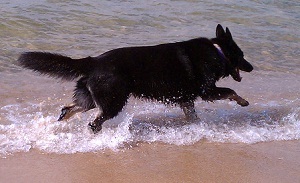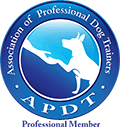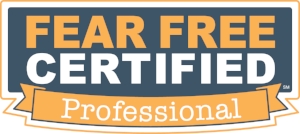OnLine Training :: Taking Home Your New Dog
What an exciting time! You're taking home a new canine companion to join your family! You want to set things off on the right paw, but there are so many things to think about and to plan. Well, to that end, here is a quick guide to the key skills to build in your dog to assure a wonderful life together...AN ENRICHED LIFE
Exercise
| Whatever the weather, young medium- to large-breed dogs need an average of two hours of exercise a day, and 30 minutes of that time needs to be aerobic in nature. Dogs fit beautifully in the human lifestyle because they are crepuscular, meaning that they are typically their most active in the morning and |

| |
|
the evening. So the ideal routine for the average dog is an hour of exercise in the morning before you go to work, including some aerobic activity; then a dog walker for a bit of a break half way through the day; and an hour of exercise at night.
What are some ways of providing aerobic activity? Perhaps going for a jog/run together, playing fetch in the yard (preferably uphill so that your dog is working even a little harder), or dog play for the dog-friendly dog. Note: Some effort and attention will need to be spent during these early days getting your new dog acclimated to the crate for those spans of time when he is resting throughout the day. | ||
Mental Stimulation
| We all require both physical exercise and mental stimulation in order to live a well-balanced life, and dogs are no exception. Feeding meals and snacks out of puzzle toys like the Kong provide a great outlet for mental energy (see the WoofGang handout Kongs Fit for a King). Training is another great way to make a dog work mentally. Dog sports like nosework and games like "go find it" can offer great mental gymnastics of the olfactory variety and can be fun for dog and human alike! |

|
Quality Time and Play
| Quality time spent together is so essential in building a deep and bonded relationship, and play is an important part of that. Especially in these early days and weeks, the things you do together will have lasting impact on your connectedness. |

| |
|
Training is the foundation to any mutually respectful, loving relationship, and play is the cement to that foundation. When playing, make sure to establish games with rules, with your dog dropping the toy when cued to and not rudely grabbing the toy before it's offered. For dogs with arousal issues, make sure to interleave play with calm behaviors (sit or down) so that he doesn't get too riled up. Leave a leash dragging if you think that he might get out of control so that you can put him in a time-out if necessary.
Finally, shared quiet time, with massage and petting can be wonderful for both giver and receiver! | ||
CRATING
|
The crate is an essential tool for easing your dog's adjustment to a new home.
Of course, you want your dog to love his crate, not have to spend time cooped up in a place that he hates. So it's essential in these first days together that you immediately teach him that good things happen in the crate and that it's a great place for some quiet alone time. Please see WoofGang's crate-training handout for tips. |

|
ALONENESS
Dogs need to learn to tolerate time alone right from the start. As exciting as it is to bring home your new dog and as tempted as you might be to spend every waking moment with him in these first days, don't! In a few short days, something will call you away and your dog will be left alone and, if he hasn't been prepared to do this happily, it may be a rude awakening for him.
Right from day one, and every day thereafter, design and keep a routine that includes exercise, togetherness, and alone time. The crate is the best place for him to spend his alone time, stocked with a stuffed puzzle toy and other toy distractions. Make sure that he gets plenty of exercise prior to his quiet time so that he is ready for a nap, because even a dog who doesn't have separation issues per se can just get bored and destructive if he's still raring to go! And take a look at WoofGang's handout on Preventing Separation Anxiety for practical tips.
DAILY ROUTINE
Your day together with your new dog should consist of the following repeated pattern: coming out of the crate after a rest, going immediately outside for a potty break and some exercise, coming back inside and going back into the crate with a stuffed meal/snack Kong for a little rest, only to start the pattern all over again. In the beginning, there will be many repetitions, short in length, but gradually your dog should be able to tolerate longer spans resting in the crate so that the pattern is only repeated a few times over the course of the day.
BUILDING TRUST AROUND RESOURCES
Many breeds of dogs have a propensity to guard their resources. If you think about it, humans guard our resources, too, putting locks on our doors!
Often guarding will diminish as a dog builds trust in his family, as it is a relationship-based behavior. So, when first bringing a dog home, be careful around food, chewies, toys and stolen objects. Feed in the crate so that your dog is buttoned up at meal time as you build a trusting relationship together. While he's eating, toss tasty treats as you pass the crate so that your dog is learning that your proximity means good things! Teach your dog the cue "drop it!" and that sharing toys with you is advantageous, because tasty treats result and then the toy is returned -- it's a win-win!
Finally, take note of any warning behaviors when resources are present -- body stiffness, stillness or freezing, hunkering over something, eye whites. Such warnings are important indications of your dog's discomfort with your presence near that object. Make sure not to yell or punish this warning behavior because then you may cause him to escalate to a growl or even a bite. Instead, consider these warnings as homework assignments of things you and your dog still need to build trust around. WoofGang would be happy to help you work on this.
REDUCING AROUSAL -- BUILDING IMPULSE CONTROL
|
Many dogs, especially young adolescents, may be jumpy and mouthy, even humpy, when they interact with people, especially in play, because no one took the time early on to train them more polite behavior and more appropriate play skills.
Exercise, mental stimulation and impulse control training are the best ways of teaching a dog how to interact with people more appropriately. A tired dog really is a good dog! Physical exercise will blow off some steam; stuffed puzzle toys (like the Kong) will |

| |
| give your dog a way of burning mental energy, which is also exhausting in its own way; and training impulse control can teach a dog alternate polite behaviors to get the things he wants in life. For dog-friendly dogs, dog play can be a great way of blowing off steam and also reducing mouthiness. Also remember to play games with rules (WoofGang handout available upon request) and always use toys in play. | ||
MEETING NEW PEOPLE
|
These first days and weeks are a big adjustment for your new dog, so keep things low-key. Now's not the time to have a party to introduce your new canine family member to all your closest friends! Instead, concentrate on your own relationship with each other first and do some training, particularly impulse control exercises, so that he learns polite behaviors that he can draw on as he starts to meet more people.
Teach your dog how to be a polite citizen in every situation and that polite behavior, like sitting quietly at your side when meeting new people, results in tasty treats, and potentially even treats from the stranger! |

| |
| In the process, you may notice that your dog shows a little shyness around certain people, like men in uniforms or children on bikes. Direct interaction with these people should not be attempted. Instead you should be feeding the treats while your dog is offering polite behavior. Remember, dogs do not need to love everyone nor do they need to be petted by everyone -- the important thing is that they can be polite and calm in everyone's presence. | ||
CHILDREN
|
Though there are many breeds of dogs in the world, there are really only three types of dogs when it comes to children: those who turn inside out with excitement at seeing a child, those who tolerate the presence of children, and those who do not like children. Ideally, dogs living in a home with children are from the first group -- the kid-lovers.
For kids and dogs to live in safe, peaceful coexistence, there need to be rules. WoofGang's Kids and Dogs article will give you greater detail on this important ground rules. |

|
OTHER ANIMALS
Meeting Other Dogs
This is a time of great adjustment so don't throw too much at your new dog at once. While on walks take note of your dog's behavior when seeing other dogs at a distance. Does he look social, interested, aroused, uncertain, frustrated, avoidant, ...? Start using treats to redirect his attention back to you so that he's less intent on the other dog and gradually pass at closer distances. Then you can start seeing how he is in closer proximity to different types of dogs -- high energy dogs, low-key dogs, small ones, large ones, dogs of different coat colors and breeds. Make play dates with friends' dogs, spending time parallel walking and see if the two dogs can get gradually closer and how he looks when they do. Don't rush this -- take the time to investigate what types of dogs make him the most comfortable.
Note: Going to the dog park is not a good idea at all. That is inviting a pack of dogs who you know nothing about to interact with your new dog, who you know little about. It's just asking for trouble.
Another Note: For a very dog-friendly dog, the comradery of other dogs may help him adjust to walks in the new neighborhood. So if you notice that your dog becomes looser and more animated at the sight of other dogs on walks, enlist their aid by taking walks together.
Housemate Animals
For detailed techniques for introducing your new dog to resident dogs or cats, please consult WoofGang's Keeping the Peace article.
HANDLING
Some dogs are sensitive to particular types of handling, such as collar grabs or when a part of their body is touched, like their paws or tail. Even dogs who are fairly tolerant to handling can benefit from associating collar grabs and body touches with tasty treats. Sometimes handling sensitivities may subside as they build a relationship with their people but they may still have these sensitivities when at the vet or groomer. It may be prudent to muzzle your dog in these circumstances and so it is advisable to desensitize him to the use of the muzzle.
PUPPIES
Taking home a new puppy may seem like you won't need to worry about a dog having a potential history of issues because you're starting with a blank book. But it's actually even more of a challenge to be a good puppy parent, precisely because you're starting with a blank book! You are the one who needs to fill this tome with page after page of good experiences -- with people, with animals, with new experiences, with bite inhibition, with aloneness tolerance, and the list goes on. The lessons you miss now will become more pronounced as your dog reaches social maturity, at around 18 months or so, and then it will be too late. Because, instead of writing fresh new pages, you will be overlaying an already written book.
So training at this tender age is crucial, and training by positive humane techniques is the only acceptable approach. WoofGang offers a private 4-session puppy package (for puppies under 4 months) that covers socialization, housetraining, crate-training, resource guarding prevention, chew training and bite inhibition training, restraint and handling, aloneness training, and then basic cue training. Consult WoofGang article Puppy Socialization -- Helping your Puppy Make Friends for the first steps of this essential education.
TRAINING
| Training is the language that binds. It provides a shared vocabulary of behaviors and skills so that you can communicate your needs to your dog without causing him frustration or confusion. It is also a great way to build relationship, especially in these early weeks and months together. A well-trained dog can accompany you more places and will be invited to join more activities precisely because of his exemplary behavior. And training sessions will be fun for the family members at both ends of the leash! |

| |
| WoofGang offers private sessions in relationship training as well as behavior modification for problem behaviors. Please contact us or call (6 4 6) 345.5116 for more information. | ||




